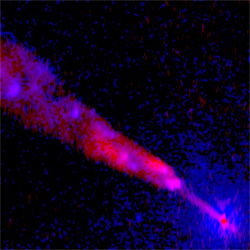April 1, 2003
RAS Press Notice PN03-17
By combining radio and X-ray observations, astronomers have obtained their most detailed view yet of the effects a powerful galactic jet has as it blasts its way through stars and gas on its way out from the centre of a galaxy. New observations of our nearest neighbouring radio galaxy, Centaurus A, (10 million light years away in the southern sky) show intense X-rays in places where the fast-moving jet is apparently running into the gas and stars that make up the galaxy. Because Centaurus A is the nearest radio galaxy, it is a key object for understanding how all other radio galaxies work. Results from the research will be presented at the UK/Ireland National Astronomy Meeting in Dublin by Dr Martin Hardcastle of the University of Bristol.
Only a small minority of galaxies have powerful jets of electrically charged particles but, where they are present, they can have profound effects on the galaxies they inhabit. They are believed to come from close to a central massive black hole and in many cases they extend for hundreds of thousands of light years. Astronomers have been aware of radio emission and visible light from such jets for many years, but more recently, scientists using the orbiting observatory Chandra have discovered that X-ray emission from jets is also common. The X-rays come from electrons carrying large amounts of energy - comparable with the energies reached in the accelerators used in particle physics experiments on Earth.
The team working on Centaurus A, led by Dr Hardcastle, a Royal Society Research Fellow at the University of Bristol, and Dr Ralph Kraft, of the Harvard-Smithsonian Center for Astrophysics in the USA, observed its jet with both Chandra and the Very Large Array radio telescope in New Mexico. The radio observations, taken between 1991 and 2002, showed that parts of the jet are moving away from the centre of the galaxy at speeds of about half the speed of light. However, the regions of the jet that are emitting the most X-rays were stationary. The interpretation the team put on this finding is that the stationary regions are where the jet is stalled when it encounters clouds of gas or peculiar stars. The X-ray emission would be produced by the powerful shock generated as the fast jet flow runs into the stationary material. If this is true, it would be the first time that interactions in a jet have been seen in so much detail.
The team believe that their research will have implications for the study of other, more distant galactic jets. "Because Cen A is the closest radio galaxy to us, and we can image its jet so clearly, it's a key object," said Dr Hardcastle. "We really need to understand it if we're going to understand any of the others."
MEDIA CONTACTS
Issued by Jacqueline Mitton and Peter Bond, RAS Press Officer.



